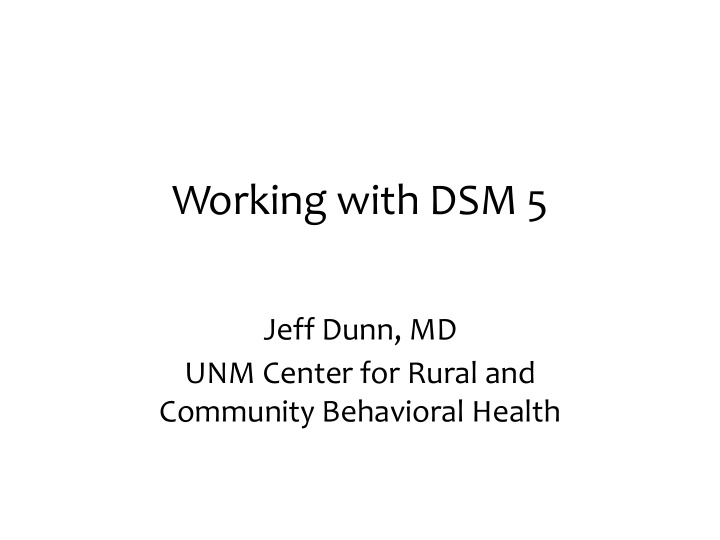



Working with DSM 5 Jeff Dunn, MD UNM Center for Rural and Community Behavioral Health
Criticisms/Controversies Lack of transparency? (non-disclosure agreements) Low reliability (kappa) in field trials Ties to pharmaceutical industry? (70 % of task force members) “Medic a lization” of normal responses or normal individual variation? (dropping of bereavement exclusion from MDD; binge eating d/o; DMDD; mild neurocognitive disorder)
Elimination of Multi-axial System “ To remove artificial distinctions between medical and mental disorders” Axis IV: a number of psychosocial and environmental conditions can be coded as V Codes Axis V (GAF): replaced by WHO Disability Assessment Schedule and other assessment measures: http://www.psychiatry.org/practice/dsm/dsm5/online- assessment-measures
NEURODEVELOPMENTAL DISORDERS
Intellectual Disability Intellectual Disability (Intellectual Developmental Disorder) replaces the term Mental Retardation Severity is determined by adaptive functioning rather than cognitive capacity (IQ)
Autism Spectrum Disorder Encompasses autism, Asperger’s dis order, childhood disintegrative disorder and pervasive developmental disorder NOS (aside: NOS replaced with other specified disorder or unspecified disorder) Characterized by 1) deficits in social communication and social interaction and 2) restricted repetitive behaviors
ADHD For children, onset has been changed from before 7 years of age to before 12 years of age for adults, symptom cutoff is 5 symptoms instead of 6 symptoms Symptoms continue to be drawn from inattention cluster and hyperactivity/impulsivity cluster Co-morbid diagnosis of ASD now allowed
PSYCHOTIC DISORDERS
Schizophrenia Schizophrenia subtypes have been dropped Individual must have at least one of the following: delusions, hallucinations, disorganized speech Bizarre delusions or “first ra n k” hallucinations no longer given special weight
Schizoaffective Disorder Now requires that a major mood episode be present for a majority of the disorder’s total duration
Delusional Disorder Removes requirement that delusions be non-bizarre
BIPOLAR AND RELATED DISORDERS
Bipolar Disorder Emphasizes changes in activity and energy during a manic or hypomanic episode, as well as mood “M ixed Episode ” has been removed; replaced with specifie r “with m ixed f eatures” (can also be applied to MDD) A specifie r for “anxious dis tress ” has also been added
DEPRESSIVE DISORDERS
Disruptive Mood Dysregulation Disorder* “ To address concerns about potential overdiagnosis and overtreatment of bipolar disorder in children. ” For children 6-18 years old who exhibit persistent irritability and frequent episodes of extreme behavioral dyscontrol (temper outbursts) Symptoms present for at least 12 months in at least 2 settings
Major Depressive Disorder Criteria largely unchanged, with important exception of elimination of the “bereavement exclusion” Formerly, MDD could not be diagnosed within 2 months following the death of a loved one Guidelines for distinguishing grief from MDD given in a footnote (eg, grief: occurs i n “pangs”, pos itive emotion still present, self esteem preserved)
Persistent Depressive Disorder Includes dysthymic disorder (dropped from DSM 5) and chronic major depressive disorder “depress ed mood for most of the day, on more days than not… for at least 2 years”
Premenstrual Dysphoric Disorder Moved from Appendix to “main body” “in the major ity of menstrual cycles, at least 5 symptoms must be present in the final week before the onset of me nses”
ANXIETY DISORDERS
Panic attack ( unexpected and expected ) can be added as a specifier to all DSM 5 diagnoses Panic Disorder and Agoraphobia are now listed as two separate disorders Requirement that individuals recognize their anxiety as excessive has been deleted 6 month duration for agoraphobia, specific phobia, and social phobia
OBSESSIVE COMPULSIVE AND RELATED DISORDERS*
Hoarding Disorder* Persistent difficulty discarding or parting with possessions due to a perceived need to save the items and distress associated with discarding them
Excoriation (Skin-Picking Disorder)* Constant and recurrent skin picking, resulting in skin • lesions Individuals have made repeated attempts to decrease or stop the skin picking 2-4% of population?
TRAUMA AND STRESSOR RELATED DISORDERS*
Disinhibited Social Engagement Disorder* Once a subtype of reactive attachment disorder (indiscriminately social/disinhibited vs emotionally withdrawn/inhibited), now a separate diagnosis
Posttraumatic Stress Disorder Criteria A explicit regarding whether individual has experienced trauma directly, witnessed trauma, or experienced indirectly Subjective reaction (“fear, helplessness, horror”) has been eliminated Expansion to 4 symptom clusters: intrusion, alterations in arousal and reactivity, avoidance, persistent alterations in cognition and mood
SOMATIC SYMPTOM AND RELATED DISORDERS
Somatic symptom disorder (individuals with somatic symptoms — who may or may not have a diagnosed medical condition — plus maladaptive thoughts, feelings and behaviors) replaces somatization disorder and undifferentiated somatoform disorder Hypochondriasis has been dropped — cases now to be diagnosed with SSD or illness anxiety disorder (the latter if no somatic symptoms present)
FEEDING AND EATING DISORDERS
For anorexia, requirement for amenorrhea has been dropped For bulimia, threshold has been lowered from 2 episodes per week to 1 BINGE EATING DISORDER*- recurring episodes of bingeing (minimum: once weekly for 3 months) accompanied by feelings of guilt or embarrassment
GENDER DYSPHORIA
Emphasizes gender incongruence rather than cross gender identification per se (as in DSM IV gender identity disorder) Separate criteria sets for children and adults
DISRUPTIVE, IMPULSE CONTROL, AND CONDUCT DISORDERS
Oppositional Defiant Disorder-three subtypes: angry/irritable; vindictiveness; argumentative/defiant; conduct disorder exclusion removed Intermittent Explosive Disorder-physical aggression was required in DSM IV, whereas verbal aggression and non-destructive/non-injurious physical aggression now suffice
SUBSTANCE RELATED AND ADDICTIVE DISORDERS
NEW ADDITIONS Gambling disorder (moved from Disorders of Impulse Control) Tobacco Use Disorder Cannabis withdrawal Caffeine withdrawal
Criteria/Terminology Changes Abuse and dependence no longer separated; subsumed under category Substance Use Disorder Criteria nearly identical, with two exceptions: “rec urrent legal p roblems” dropped; craving or strong desire to use substance added Threshold is two criteria; severity is based on the number of criteria: 2-3 mild; 4-5 moderate; 6 or more severe Substance, rather than category, should be specified
NEUROCOGNITIVE DISORDERS
Major and Mild Neurocognitive Disorder* Major Neurocognitive Disorder replaces terms dementia and amnestic disorder Mild Neurocognitive Disorder-a level of cognitive decline that goes beyond normal aging and requires the person be engaging in compensatory strategies to maintain independence
Recommend
More recommend